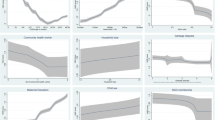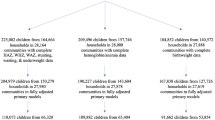Abstract
Aim
Child malnutrition is also associated with higher incidence of morbidity and mortality. Therefore, it is imperative to have knowledge of its correlates and determinants. The objective of this paper is to examine the association between demographic and socioeconomic factors and child nutritional status in Bangladesh.
Subject and methods
A secondary data analysis was conducted using the 2014 Bangladesh Demographic and Health Survey data. The surveys used a stratified two-stage cluster sampling. In the first stage, 600 enumeration areas (EAs) were selected with probability proportional to the EA size. In the second stage of selection, a fixed number of 30 households per cluster will be selected with an equal probability systematic selection from the household listing. The sample constitutes 17,886 ever-married women age 15–49, with 34.38% and 65.62% from urban and rural areas respectively. The anthropometric indicators height-for-age, weight-for-age and weight-for-height z-scores were used as the primary and secondary outcome measures.
Results
Results show that age and birth order of child is negatively associated with height-for-age, weight-for-age, and weight-for-height z-scores. However, the size of the child at birth is positively allied with the three anthropometric indicators. Mothers’ BMI and educational level are positively connected with the nutrition z-scores, but these factors have differential effects at different points of the conditional distribution of the anthropometric z-scores. Moreover, the economic status of a family is an essential factor in determining the z-score of height-for-age, weight-for-age, and weight-for-height of a child.
Conclusion
The age, size of child at birth, mother’s BMI and educational status, and wealth index are very important determinants of the z-score of the anthropometric indicators of a child. In order to improve the nutritional status of children in Bangladesh, the authors suggest that a joint effort by the government, non-governmental organizations, and the community is absolutely essential.




Similar content being viewed by others
References
Ahmed T, Ahmed AMS (2009) Reducing the burden of malnutrition in Bangladesh. BMJ 339:b4490. https://doi.org/10.1136/bmj.b4490
Arnold F, Nangia P, Kapil U (2004) Indicators of nutrition for women and children: current status and recommendations. Econ Polit Wkly 39(7):664–670. https://doi.org/10.2307/4414641
Aturupane H, Deolalikar AB, Gunewardena D (2011) Determinants of child weight and height in Sri Lanka: a quantile regression approach. In: McGillivray M, Dutta I, Lawson D (eds) Health inequality and development. Studies in Development Economics and Policy. Palgrave Macmillan, London. https://doi.org/10.1057/9780230304673_4
Bairagi R, Chowdhury MK (1994) Socio-economic and anthropometric status and mortality of young children in rural Bangladesh. Int J Epidemiol 23:1197–1281
Bassolé L (2007) Child malnutrition in Senegal: does access to public infrastructure really matter? A quantile regression analysis. Paper presented at the African Economic Conference: Opportunities and Challenges of Development for Africa in the Global Arena, Addis Ababa, Ethiopia, November 2007, Vol. 1517
Bégin F, Habicht JP, Frongillo EA, Delisle H (1997) The deterioration in children’s nutritional status in rural Chad: the effect of mothers’ influence on feeding. Am J Public Health 87(8):1356–1359
Black RE, Allen LH, Bhutta ZA, Caulfield LE, De Onis M, Ezzati M, Mathers C, Rivera J (2008) Maternal and child undernutrition: global and regional exposures and health consequences. Lancet 371(9608):243–260. https://doi.org/10.1016/S0140-6736(07)61690-0
Bomela NJ (2009) Social, economic, health and environmental determinants of child nutritional status in three central Asian republics. Public Health Nutr 12(10):1871–1877
Borooah VK (2005) The height-for-age of Indian children. Econ Hum Biol 3(1):45–65
Chowdhury MH, Mim FN, Satu SA (2018) Prevalence and risk factors of child malnutrition in Bangladesh. Research & Reviews: Journal of Statistics and Mathematical Sciences 4(2):24–31
Das S, Fahim SM, Islam MS, Biswas T, Mahfuz M, Ahmed T (2019a) Prevalence and sociodemographic determinants of household-level double burden of malnutrition in Bangladesh. Public Health Nutr 22(8):1425–1432. https://doi.org/10.1017/s1368980018003580
Das S, Gulshan J (2017) Different forms of malnutrition among under five children in Bangladesh: a cross sectional study on prevalence and determinants. BMC Nutrition 3:1. https://doi.org/10.1186/s40795-016-0122-2
Das S, Hossain MZ, Islam MA (2008) Predictors of child chronic malnutrition in Bangladesh. Proc Pakistan Acad Sci 45(3):137–155
Das S, Rahman A, Ahamed A, Rahman ST (2019b) Multi-level models can benefit from minimizing higher-order variations: an illustration using child malnutrition data. J Stat Comput Simul 89(6):1090–1110. https://doi.org/10.1080/00949655.2018.1553242
Demissie S, Worku A (2013) Magnitude and factors associated with malnutrition in children 6–59 months of age in pastoral community of dollo ado district, Somali region, Ethiopia. Sci J Public Health 1(4):175–183. https://doi.org/10.11648/j.sjph.20130104.12
Faruque ASG, Ahmed AMS, Ahmed T, Islam MM, Hossain MI, Roy SK, Alam N, Kabir I, Sack DA (2008) Nutrition: basis for healthy children and mothers in Bangladesh. J Health Popul Nutr 26:325–339
Fenske N, Burns J, Hothorn T, Rehfuess EA (2013) Understanding child stunting in India: a comprehensive analysis of socio-economic, nutritional and environmental determinants using additive quantile regression. PLoS One 8(11):e78692
Henry FJ, Briend A, Fauveau V, Huttly SA, Yunus M, Chakraborty J (1993) Gender and age differentials in risk factors for childhood malnutrition in Bangladesh. Ann Epidemiol 3(4):382–386. https://doi.org/10.1016/1047-2797(93)90065-C
Hossain MM, Majumder AK (2019) Determinants of the age of mother at first birth in Bangladesh: quantile regression approach. J Public Health 27:419–424. https://doi.org/10.1007/s10389-018-0977-6
Jesmin A, Yamamoto SS, Malik AA, Haque MA (2011) Prevalence and determinants of chronic malnutrition among preschool children: a cross-sectional study in Dhaka city. Bangladesh J Health Popul Nutr 29:494–499
Kabir MR, Rahman M, Al-Mamun MA, Islam H (2018) Prevalence of malnutrition and associated factors affecting the nutritional status of Adivasi (tribal) children aged 24-59 months in Bangladesh. Asian J Med Biol Res 4(2):178–185. https://doi.org/10.3329/ajmbr.v4i2.38253
Kabubo-Mariara J, Ndenge GK, Mwabu DK (2009) Determinants of children’s nutritional status in Kenya: evidence from demographic and health surveys. J Afr Econ 18(3):363–387
Koenker R, Bassett G (1978) Regression quantiles. Econometrica 46(1):33–50. https://doi.org/10.2307/1913643
Mazumdar S (2010) Determinants of inequality in child malnutrition in India: the poverty-under-nutrition linkage. Asian Popul Stud 6(3):307–333
Megabiaw B, Rahman A (2013) Determinants of chronic malnutrition among under in Ethiopia. Int J Ch Nutr 2(3):230–236
Mishra V, Roy TK, Retherford RD (2004) Sex differentials in childhood feeding, health care, and nutritional status in India. Popul Dev Rev 30(2):269–295. https://doi.org/10.1111/j.1728-4457.2004.013_1.x
Muaz SSA, Hasan MR, Shamim SA, Dev A, Kamar S (2010) Nutritional status of 1-5 years children of the tea workers in Sylhet division. Bangladesh J Child Health 34(1):11–16
Nair KRG (2007) Malnourishment among children in India: a regional analysis. Econ Polit Wkly 42(37):3797–3803
National Institute of Population Research and Training (NIPORT) (2016) Bangladesh demographic and health survey 2014. NIPORT, Mitra and Associates, and ICF International; Dhaka, Bangladesh, and Rockville MD
Olsen CS, Clark AE, Thomas AM, Cook LJ (2012) Comparing least-squares and quantile regression approaches to analyzing median hospital charges. Acad Emerg Med 19(7):866–875. https://doi.org/10.1111/j.1553-2712.2012.01388.x
Pathak PK, Singh A (2011) Trends in malnutrition among children in India: growing inequalities across different economic groups. Soc Sci Med 73(4):576–585. https://doi.org/10.1016/j.socscimed.2011.06.024
Rabbi AMF, Karmaker SC (2015) Determinants of child malnutrition in Bangladesh-a multivariate approach. Asian J Med Sci 6(2):85–90. https://doi.org/10.3126/ajms.v6i2.10404
Rahman A (2016) Significant risk factors for childhood malnutrition: evidence from an Asian developing country. Science J Public Health 4(1):16–27
Rahman A, Chowdhury S (2007) Determinants of chronic malnutrition among preschool children in Bangladesh. J Biosoc Sci 39(2):161–173. https://doi.org/10.1017/S0021932006001295
Rahman A, Chowdhury S, Hossain D (2009) Acute malnutrition in Bangladeshi children: levels and determinants. Asia Pac J Public Health 21(3):294–302. https://doi.org/10.1177/1010539509335399
Rahman A, Chowdury S, Karim A, Ahmed S (2008) Factors associated with nutritional status of children in Bangladesh: a multivariate analysis. Demography India: population – society – economy – environment – interactions 37(1):95–109
Rayhan I, Khan MSH, Shahidullah M (2007) Impacts of biosocial factors on morbidity among children aged under-5 in Bangladesh. Asia Pac Popul J 22(1):65–75
Sharaf MF, Mansour EI, Rashad AS (2019) Child nutritional status in Egypt: a comprehensive analysis of socioeconomic determinants using a quantile regression approach. J Biosoc Sci 51:1–17. https://doi.org/10.1017/S0021932017000633
Siddique MNA, Haque MN, Goni MA (2011) Malnutrition of under five children: evidence from Bangladesh. Asian J Med Sci 2:113–119
Sweeney S, Davenport F, Grace K (2013) Combining insights from quantile and ordinal regression: child malnutrition in Guatemala. Econ Hum Biol 11(2):164–177
Talukder A (2017) Factors associated with malnutrition among under-five children: illustration using Bangladesh Demographic and Health Survey, 2014 data. Children 4:88. https://doi.org/10.3390/children4100088
Tarozzi A, Mahajan A (2007) Child nutrition in India in the nineties. Econ Dev Cult Chang 55(3):441–486. https://doi.org/10.1086/511195
Victora CG, Adair L, Fall C, Hallal PC, Martorell R, Richter L, Sachdev HS (2008) Maternal and child undernutrition: consequences for adult health and human capital. Lancet 371(9609):340–357. https://doi.org/10.1016/S0140-6736(07)61692-4
WHO (1986) Use and interpretation of anthropometric indicators of nutritional status. Bull WHO 64:929–941
WHO (2017) The double burden of malnutrition: policy brief. Report No.: WHO/NMH/NHD/17.3. WHO, Geneva. http://www.who.int/nutrition/publications/doubleburdenmalnutrition-policybrief/en/. Accessed 10 Mar 2020
Yeh CC, Wang KM, Suen YB (2009) Quantile analyzing the dynamic linkage between inflation uncertainty and inflation. Probl Perspect Manag 7(1):21–28
Acknowledgements
The authors are grateful to ICF International, Rockville, Maryland, USA, for providing the Bangladesh DHS data sets for this analysis. The access link of data set is http://dhsprogram.com/data/available-datasets.cfm. We would also like to sincerely thank the two anonymous reviewers and the Editor for their valuable comments which were used to improve the manuscript.
Contributors
AR and MMH were involved in the conception and design of this study. MMH carried out the analysis and drafted the manuscript under the guideline of AR. AR provided data analysis and interpretation advice, and revised and edited the final manuscript. All the authors read and approved the manuscript. AR and MMH both were involved in revising the manuscript.
Data sharing
Data used in this research were freely accessible at the web-link: http://dhsprogram.com/data/available-datasets.cfm
Funding
This research received no specific grant from any funding agency in the public, commercial or not-for-profit sectors.
Author information
Authors and Affiliations
Corresponding author
Ethics declarations
Competing interests
None declared.
Ethics approval
This study was based on an analysis of existing public domain survey data sets that is freely available online with all identifier information removed. The survey was approved by the Ethics Committee of the ICF Macro at Calverton in the USA and by the Ethics Committee in Bangladesh.
Additional information
Publisher’s note
Springer Nature remains neutral with regard to jurisdictional claims in published maps and institutional affiliations.
Rights and permissions
About this article
Cite this article
Rahman, A., Hossain, M.M. Quantile regression approach to estimating prevalence and determinants of child malnutrition. J Public Health (Berl.) 30, 323–339 (2022). https://doi.org/10.1007/s10389-020-01277-0
Received:
Accepted:
Published:
Issue Date:
DOI: https://doi.org/10.1007/s10389-020-01277-0




